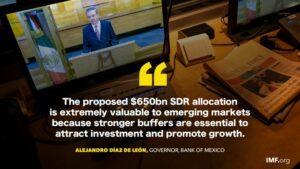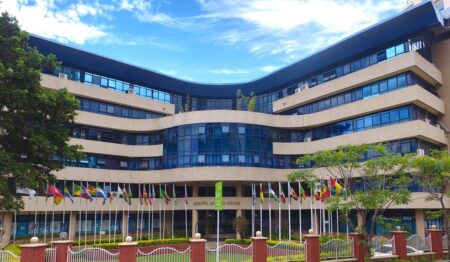The Board of Governors of the International Monetary Fund has approved a general allocation of Special Drawing Rights (SDRs) equivalent to US$650 billion (about SDR 456 billion), to boost global liquidity.
In a statement, IMF Managing Director Kristalina Georgieva termed the move as historic, adding that it is the largest SDR allocation in the history of the IMF.
The SDR is an international reserve asset created by the IMF to supplement the official reserves of its member countries.
The IMF adds that SDR is not a currency, but has a potential claim on the freely usable currencies of IMF members. As such, SDRs can provide a country with liquidity.
“Special Drawing Rights (SDRs) are an asset, though not money in the classic sense because they cannot be used to buy things. The value of an SDR is based on a basket of the world’s five leading currencies – the US dollar, euro, yuan, yen and the UK pound. The SDR is an accounting unit for IMF transactions with member countries – and a stable asset in countries’ international reserves,” IMF says on its website.
Georgieva said the funding will be a shot in the arm for the global economy at a time of unprecedented crisis.
According to Georgieva, the allocation is expected to benefit all members, address the long-term global need for reserves, build confidence, and foster the resilience and stability of the global economy.
“It will particularly help our most vulnerable countries struggling to cope with the impact of the COVID-19 crisis,” she said.
The IMF funding will become effective on August 23, 2021, and will be credited to IMF member countries in proportion to their existing quotas in the Fund.
Developing Countries targeted
According to the IMF, about US$275 billion of the new allocation will go to emerging markets and developing countries, including low-income countries.
“We will also continue to engage actively with our membership to identify viable options for voluntary channeling of SDRs from wealthier to poorer and more vulnerable member countries to support their pandemic recovery and achieve resilient and sustainable growth,” Georgieva said.
Tanzania to secure $660 million to boost economy
As per the IMF, one key option is for members that have strong external positions should voluntarily channel part of their SDRs to scale up lending for low-income countries through the IMF’s Poverty Reduction and Growth Trust (PRGT).
According to the fund, concessional support through the PRGT is currently interest free.
“The IMF is also exploring other options to help poorer and more vulnerable countries in their recovery efforts. A new Resilience and Sustainability Trust could be considered to facilitate more resilient and sustainable growth in the medium term,” the Fund said.

So far, the Fund has allocated a total of SDR 204.2 billion (equivalent to about US$318 billion), including three general allocations and a one-time special allocation.
These are SDR 9.3 billion was allocated in yearly installments in 1970–72, SDR 12.1 billion was allocated in yearly installments in 1979–81, and SDR 161.2 billion was allocated on August 28, 2009, by far the biggest allocation to date.
The funding comes at a time when the global economy has been projected to grow 6 percent in 2021 and 4.9 percent in 2022.
Treasury calls for input on 2018/19 budget, sets spend at Ksh2.5 trillion
The 2021 global forecast is unchanged from the April 2021 World Economic Outlook, but with offsetting revisions.
According to the IMF, prospects for emerging market and developing economies have been marked down for 2021, especially for Emerging Asia.
“These revisions reflect pandemic developments and changes in policy support. The 0.5 percentage-point upgrade for 2022 derives largely from the forecast upgrade for advanced economies, particularly the United States, reflecting the anticipated legislation of additional fiscal support in the second half of 2021 and improved health metrics more broadly across the group.”
Overall, vaccine access has emerged as the principal fault line along which the global recovery splits into two blocs: those that can look forward to further normalization of activity later this year (almost all advanced economies) and those that will still face resurgent infections and rising COVID death tolls.
“The recovery, however, is not assured even in countries where infections are currently very low so long as the virus circulates elsewhere,” the IMF says.











